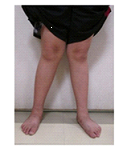In genral, the lower extremities of the baby are prone to form bowlegs due to fetal pressure. The deformity worsens after birth when walking due to weight bearing. Then the musculoskeletal system continues to develop to support the weight of the body, the lower extremity become straight when one and a half year old. However, at the age of 3, they become knock-knees due to the pendulum effect until the age of 6 or 7 when most children's lower limb alignment become straight again, which is called the pendulum effect.

Genu varum
When the feet come together, the knees can't get close to each other, creating an O shape, which can be improved at the age of 2-3.
- It tends to happen in early walking, over weight, and lack of calcium or vitamin D.
- For the patients at more than 3 years old or with severe bow legs, it is necessary to consider whether there are other pathological changes or Blount disease. Blount disease is mainly caused by delayed growth of proximal medial tibia caused by trauma, infection or tumor (such children need follow-up treatment at the pediatric orthopedic clinic).

Genu Valgum
When the knees come together, the feet can't get close to each other, creating an X shape. In general, knock-knees are a process of the pendulum effect. When time comes, it will recover naturally. Treatment is required only for more serious cases or other special pathological factors, otherwise it will heal naturally.

Treatment
If the knees are still unable to return to normal alignment after 6 or 7 years old, corrective aids can be used for treatment. One of the effective procedure called guided growth, the procedure uses a implant to hold one side of the epiphyseal growth plate to guide growth balance, and the implant will not be removed until the expected effect is achieved. Because the growth plate is not injuried, , the epiphyseal growth plate can still be restored to its original posture without being affected the body height after receiving surgery.

